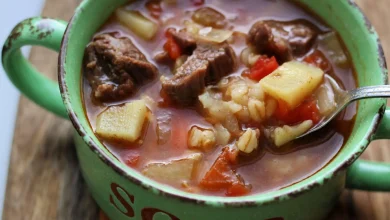Aji, also known as Aji sauce or Aji salsa, is a popular condiment in South American cuisine, particularly in countries like Peru and Colombia. It is known for its spicy and flavorful taste, often used to enhance the flavor of various dishes. Here’s a detailed breakdown of Aji:
What is Aji?
Aji is a spicy sauce or salsa made primarily from Aji peppers. It’s a versatile condiment that can range from mild to extremely hot, depending on the type and quantity of peppers used. Aji sauce is typically used as a dip or accompaniment to various foods, such as grilled meats, seafood, potatoes, and more.
History of Aji:
Aji has a rich history in South American cuisine, dating back to the Inca civilization. It has evolved over centuries, with various regions and countries putting their own spin on the recipe. Today, it’s an integral part of Peruvian and Colombian culinary traditions.
Components of Aji:
The basic components of Aji sauce include:
- Aji Peppers: These are the star ingredient and give the sauce its heat. There are different varieties of Aji peppers, with varying levels of spiciness.
- Lime Juice: Freshly squeezed lime juice adds a tangy and refreshing element to the sauce.
- Garlic: Garlic cloves provide a pungent flavor.
- Salt: To enhance the overall taste and balance the flavors.
Additional ingredients might include cilantro, onion, and sometimes vinegar, which can vary from recipe to recipe.
Steps to Prepare Aji:
Here’s a basic recipe for Aji sauce:
Ingredients:
- 4-6 Aji peppers (adjust to your desired heat level)
- 2 cloves of garlic
- Juice of 2-3 limes
- Salt to taste
- Optional: Cilantro, onion, or vinegar for added flavor
Instructions:
- Start by removing the stems and seeds from the Aji peppers if you prefer a milder sauce. For a spicier sauce, leave some seeds in.
- In a blender or food processor, combine the Aji peppers, garlic cloves, lime juice, and a pinch of salt. You can also add cilantro, onion, or a splash of vinegar if desired.
- Blend until you achieve a smooth and well-mixed sauce. Taste and adjust the salt and lime juice to your liking.
- Transfer the Aji sauce to a jar or container and refrigerate it. It’s best when allowed to sit for a few hours or overnight to let the flavors meld.
Preparation Time:
The preparation time for Aji sauce is relatively quick, usually around 15-20 minutes, depending on your chopping and blending speed. However, it’s recommended to let the flavors meld in the refrigerator for a few hours, so it’s ideal to prepare it in advance.
Aji sauce can be stored in the refrigerator for a few days, and it’s a fantastic condiment to add a spicy kick and flavor boost to a wide range of dishes. Enjoy experimenting with different Aji pepper varieties to find your preferred level of spiciness!
Certainly, here are the nutrition facts and some health information related to Aji sauce:
Nutrition Facts (Approximate, per 2 tablespoons of Aji sauce):
- Calories: 20
- Total Fat: 0g
- Saturated Fat: 0g
- Trans Fat: 0g
- Cholesterol: 0mg
- Sodium: 150mg (may vary based on added salt)
- Total Carbohydrates: 5g
- Dietary Fiber: 1g
- Sugars: 1g
- Protein: 1g
- Vitamin C: 20% of the Daily Value (DV)
- Iron: 2% DV
Health Information:
-
Low in Calories: Aji sauce is relatively low in calories, making it a suitable choice for flavoring your dishes without significantly increasing calorie intake.
-
Low in Fat: It contains little to no fat, which can be beneficial if you’re watching your fat intake.
-
Rich in Vitamin C: Aji sauce is a good source of vitamin C, providing about 20% of the daily recommended intake in a 2-tablespoon serving. Vitamin C is essential for immune health and overall well-being.
-
Low in Protein: It’s not a significant source of protein, so you should consider other protein sources in your meal.
-
Sodium Content: The sodium content may vary depending on the amount of salt added during preparation. If you’re concerned about sodium intake, you can reduce or omit salt when making Aji sauce.
-
Spiciness: The spiciness of Aji sauce comes from Aji peppers, which contain capsaicin. Capsaicin is known to have some potential health benefits, including pain relief and a boost in metabolism. However, it can also cause digestive discomfort in some individuals if consumed in excess.
-
Nutrient Variation: The exact nutritional profile of Aji sauce can vary based on the specific ingredients used in the recipe, such as the type of Aji peppers and additional components like cilantro and onions. Therefore, it’s a good idea to check the nutrition label if you’re using a store-bought Aji sauce.
Keep in mind that while Aji sauce can be a flavorful addition to your meals, its spiciness can vary greatly depending on the type and quantity of Aji peppers used. If you have a low tolerance for spicy foods, you may want to use it sparingly or choose a milder version. Additionally, if you have specific dietary concerns or health conditions, it’s a good practice to consult with a healthcare professional or nutritionist for personalized advice.




